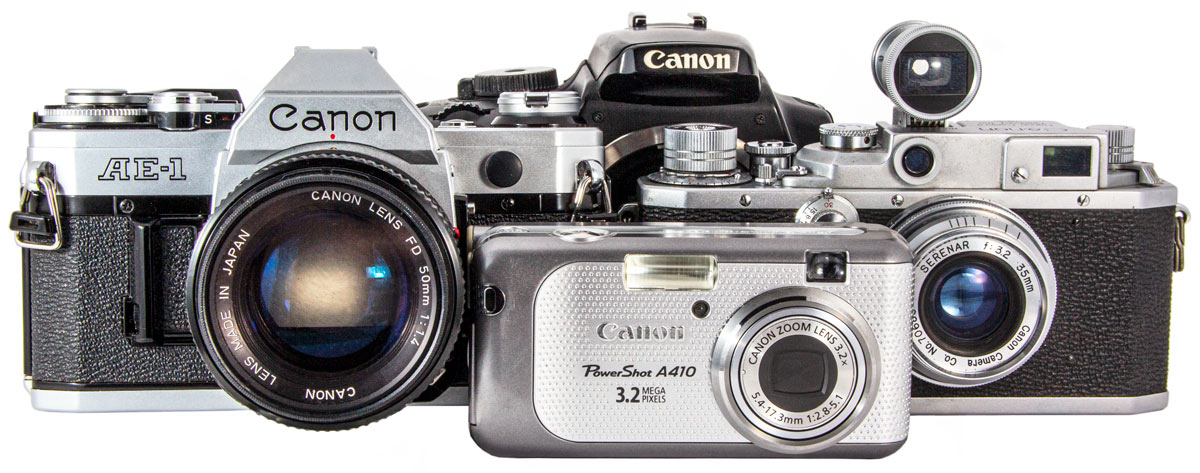
The Cameras
“The collector’s need is precisely for excess, for surfeit, for profussion … A collection is always more than is necessary.”
Susan Sontag, The Volcano Lover
Cameras come in two flavours: the one is a complete camera with a lens and the other is a camera with a detachable lens. Under the Heading of “Cameras” we include complete cameras and the bodies of cameras with interchangeable lenses. So, in this section, the word Cameras means the camera bodies where lenses detach. Lenses we will deal with seperately under their own heading.
Canon cameras and lenses can be divided into groupings or “Series”. Intentional, or not, this is a convenient way to approach the subject. You will see on the right that the Camera Menu is now showing various Series of cameras and if you select a Series you will be taken to information on that group and the cameras I have that belonging to it. If you go to the Lenses a similar menu will open up for them.
Camera Descriptions
It is not my intention to go into great descriptions of the technical details of my cameras. There are lots of web sites that will do that. Rather, I want to tell you about its history, where it fits into the Canon lineup, and what it is like to shoot it to give you a feeling for the camera and its place in its Series.
The Series and their Dates
The following table will give you an idea of where the various series of cameras fit chronologically:
| Rangefinder Series | Canon Hansa (1935) | thru | Canon 7sZ (1968) |
| R Series | Canonflex (1959) | thru | Canonflex RM (1962) |
| Canonet Series | Canonet (1961) | thru | Canonet GIII 19 (1972) |
| F Series | FX (1964) | thru | New F-1 (1981) |
| EX Series | EE (1969) | thru | EX Auto (1972) |
| A Series | AE-1 (1976) | thru | AL-1 (1982) |
| T Series | T50 (1983) | thru | T60 (1990) |
| EOS (Film) Series) | EOS 650 (1987) | thru | Rebel T2 (2004) |
| Elph | Elph (1996) | thru | Elph Z3 (2002) |
| EOS (Digital) Series | EOS DCS 3 (1995) | thru | Present |
Canon Camera Names
Canon camera names can be a problem. The rangefinders were notorious for being hard to identify. Many looked exactly alike and had no names on them. The Canonflex, “F”, “A”, and “T” series had names on them and they were the same around the world. And then it got complex.
For reasons I do not understand, for marketing purposes Canon divided the world into three areas, Europe, or International, North America and Japan and they called the same camera by different names in different areas. So if you had a “Digital Rebel XTi” you might not know that it was actually the same camera as the “EOS Kiss Digital X”. This was true for the SureShot and Power Shot cameras as well as some of the EOS film and digital cameras.
For the rangefinder cameras I created the Model Finder which will help you determine which camera you have. For the Point and Shoots and the EOS Cameras I have created Name Cross Reference Charts so that no matter which camera you want to know about you have a quick reference to find its other names. Maybe not the most useful tool but I have had occasions where it would have been useful.
The Index
This website is getting large and cumbersome. It is fun to wander around in it, however, if you know what you are looking for the fastest way to get there is through the Index. It is the last item on the Collection Menu you see on the right. Start there.
This website is the work of R. Flynn Marr who is solely responsible for its contents which are subject to his claim of copyright. User Manuals, Brochures and Advertising Materials of Canon and other manufacturers available on this site are subject to the copyright claims and are the property of Canon and other manufacturers and they are offered here for personal use only.

